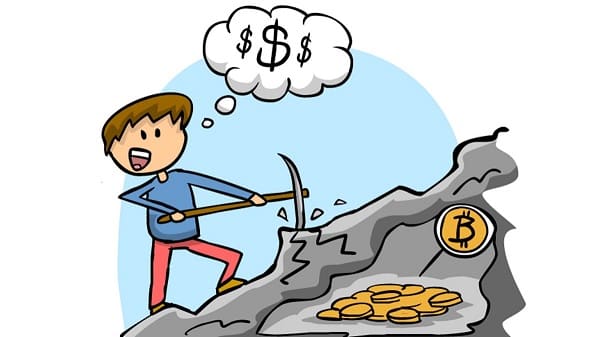
Since the evolution of cryptocurrency, bitcoin has monopolized the trading market all on its own. It attracts thousands of users worldwide every year. Alongside, there are many other virtual currencies that has taken birth around the globe. It attracts investors, merchants and other business entities.
Interest in cryptocurrencies has risen since 2015 as bitcoin has seen its valuation ascend from about $300 per coin to a pinnacle of about $20,000 per coin in December 2017, then fall to about $8,000 per coin as of November 2019. Similarly, almost all other digital currencies have seen identical incline and decline in their value. Nearly 3,000 cryptocurrencies are listed on various trading platforms, but two of bitcoin’s most popular alternatives include ethereum ($145 per coin, $15 billion market cap as of November 2019) and litecoin ($45, $2.9 billion).
While the trading business flourishes in cryptocurrency, mining is another option to earn profit from bitcoins. Miners use their computational powers to solve algorithm mathematics for blockchain and earn bitcoins as reward. Although it seems simple, it is a time and energy consuming process.
Crypto-currency mining seems like a no-brainer. To help solve complex math puzzles, set up a computer and you are rewarded with a coin or a fraction of a coin. The first Bitcoin miners were able to earn coins relatively quickly using just what computing power they had at home. But in the current generation of Blockchain, Crypto mining has become incredibly difficult, and even complex to understand. So bear with us, while we take you through the entire concept.
What is Cryptocurrency?

Digital currency or simply Crypto currency is a virtual asset based on a system that employs powerful cryptographic encryption techniques to perform secure and stable transactions and is distributed across a large number of computers. Most crypto currencies utilize decentralized networks based on distributed ledger technology or blockchain which means that each node must verify each new block generated before confirmation. Simply put, a crypto-currency is a digital currency secured by cryptography that is almost impossible to counterfeit.
The currency is 100% digital and cannot be printed like the dollars and the euros. What’s more, the Bitcoins are not controlled by any person or organization. The control goes to everyone in the system, due to the decentralized nature. This form of currency cannot be printed, as stated earlier. As such, creating more coins requires a process to take place, called “mining.”
In addition to being the most secure way of carrying out a transaction, it also attracts the lowest transaction costs, the primary reason for which is its decentralized system. Unlike conventional centralized banking systems, cryptocurrencies use each of the nodes to confirm the transaction. The conventional system can also be called the master-slave architecture in which the bank is the center of power, hence the master and all users are slaves. In contrast, decentralized cryptocurrencies exercise equal access to financial services for its each node or block.There are currently several thousand cryptocurrencies, most popular are Bitcoin, Litecoin, and Ethereum.
What is Crypto Mining?
The cryptocurrency mining techniques are all based on the same technology that makes it an encrypted, private currency. In short, it adds encryption to transactions. Cryptocurrency mining is essentially the act of legitimizing and authenticating the transactions in cryptocurrency.
Every cryptocurrency has its own hashing and authenticating algorithm. for instance, Bitcoin uses the SHA-256 algorithm, Monero uses cryptonight, Ethereum uses Ethash and so on.Your job as a miner is basically to act as a banker for the cryptocurrency. Each time someone uses the Bitcoin for a transaction, it is added to the ledger of the coin which is called a blockchain.
Blockchains record every transaction that has been made, meaning it is a lot of data to tackle. Blockchain transactions keep on increasing until they reach a “block” status. Miners then use equipment to encrypt the transactions into a hash that is added to the blockchain afterwards. To the block is added the hash which authenticates it. After they finish authenticating the hash, miners get paid.
Miners get paid in the cryptocurrency that they mine. The more you mine and register, the more coins you earn. The only problem is that you need a lot of equipment and a high-speed internet connection to do it all— and start-up costs often make entering a very hard-to-profit area.Bitcoin mining and other forms of cryptocurrency mining have previously been individual operations. Due to start-up costs and lower profit margins, they are usually done as a large-scale operation nowadays.
Here are some of the terms that are commonly associated with crypto mining.
Hash Rate
Simply put, hash is a mathematical problem which needs to be addressed. A hash rate can therefore be described as the rate at which those problems can be solved. However, over the years, the game that crypto mining is has changed. You could use your home computer to mine coins back in 2010, and get a couple of them per day.
However, as more people have joined, it’s much harder now to min the coins so more powerful computers are needed. These computers ‘ performance is measured either by hash rates in Mega Hash per second (MH / s), Giga Hash per second (GH / s), Terra Hash per second (TH / s) or finally Peta Hash per second (PH / s).
Cryptocurrency per Block

A constant amount of crypto coinsis generated each time a math problem is solved. That means coins generated per block begins at 50 and is reduced by half every four years (210,000 blocks). Today the number of Bitcoins per block awarded is 12.5. The last halved block was in July 2016, and the next is set to be in running year.
Since the entire cryptocurrency network is set to release a constant quantity of crypto coins every 10 minutes, the difficulty of solving math problems must go up to balance the equations and also balance the hash rate on the net. In a nutshell what this means is that the more miners there are, the more difficult it will be for cryptocurrencies to mine.
Energy Consumption
Crypto mining is a power-intensive activity. Each miner consumes a different power-level. You need both of those values to calculate profitability. Usually, the electricity rate appears on your monthly bill. Power consumption per rig is different but it should be shown on the device.
How does Crypto Mining take place?
Although the Bitcoin network is decentralized it has some similarities with other traditional currency forms. There has to be a record of all the transactions performed for the system to function. Otherwise, nobody would know who was paying what. The cryptocurrency network collects all transactions performed over a specific period of time to handle this, and calls it a block. It is then the job of the miner to confirm that these transactions are actually accurate, and then note them on a general ledger.
This general ledger is then joined to other general ledgers like itself and that’s what’s become known as the “blockchain.” The blockchain can be described as the master ledger where all records of any and all Bitcoin transactions are held. Whenever a new block is generated, it is automatically added to the blockchain and this updated block copy is then distributed to everyone on the network so everyone knows what’s going on. Since the general ledger has to be trusted and the blockchain’s integrity maintained, miners then have to step in and do some checking to ensure this.
The general ledger information is taken, and a mathematical formula applied to it. Once the formula is applied, the information becomes something far shorter, consisting of apparently random numbers and letters known as a hash. That hash is then stored at the end of the blockchain along with the block. Hashes are quite unique in that it’s simple to produce a hash from some data. But it is practically impossible to try to reverse engineer the hash to uncover the data. Each hash, from the next, is unique. As such, changing any character on a Bitcoin block will completely alter the entire hash.
You need both the transaction data and the hash from the last block added to the blockchain to create a hash. The hash from the previous block acts as a seal, as it asserts that the block is true and has not been manipulated. If somebody attempted to fake a transaction by modifying an already stored block, the hash would change immediately. When put through an authenticity check the block would be spotted as a fake or corrupted instantly.
Since most of the blockchains are difficult to mine, most of the crypto miners pool their resources in solving the problem collectively and share the reward. Let’s take the example of a lottery where your winning chances are tough. If individuals buy multiple lottery tickets and pool their tickets together then their chances of winning will increase. If someone wins the lottery then the reward is distributed among all the participants based on the contribution.